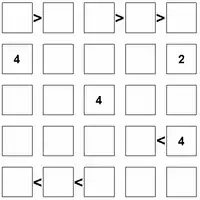Futoshiki
Futoshiki (不等式, futōshiki), or More or Less, is a logic puzzle game from Japan. Its name means "inequality". It is also spelled hutosiki (using Kunrei-shiki romanization). Futoshiki was developed by Tamaki Seto in 2001.[1]


The puzzle is played on a square grid. The objective is to place the numbers such that each row and column contains only one of each digit. Some digits may be given at the start. Inequality constraints are initially specified between some of the squares, such that one must be higher or lower than its neighbor. These constraints must be honored in order to complete the puzzle.
Solving the puzzle
Solving the puzzle requires a combination of logical techniques.[2] Numbers in each row and column restrict the number of possible values for each position, as do the inequalities.
Once the table of possibilities has been determined, a crucial tactic to solve the puzzle involves "AB elimination", in which subsets are identified within a row whose range of values can be determined. For example, if the first two squares within a row must contain 1 or 2, then these numbers can be excluded from the remaining squares. Similarly, if the first three squares must contain 1 or 2; 1 or 3; and 1 or 2 or 3, then those remaining must contain other values (4 and 5 in a 5×5 puzzle).
Another important technique is to work through the range of possibilities in open inequalities. A value on one side of an inequality determines others, which then can be worked through the puzzle until a contradiction is reached and the first value is excluded.

The first step to solve the puzzle is to enumerate possible values based on inequalities and non-duplication within rows and columns. Then AB elimination may be usable to narrow down the range of possibilities. As shown here, the top and bottom positions in the center column must contain 5 and 3, so these can be excluded from the second and fourth positions.

Logical deduction within the inequalities can restrict the range of possibilities. As shown here, a 2 in the upper left corner requires a 1 in the second position due to the first inequality; but a 1 in the second position allows only a 3 in the fifth position. This continues until we conclude that two 4s would need to be placed in the same column.
Likewise, a 3 in the upper left corner would require the top row to be 3 2 5 4 1 and the bottom again to be 1 2 3 4 5, which would lead to the same contradiction.
Only a 5 is permissible in the top left corner, from which we deduce 5 4 3 2 1 at top and 1 2 5 4 3 at bottom.
The remainder of the solution is simple elimination.
A solved futoshiki puzzle is a Latin square.
As with sudoku case, more difficult futoshiki puzzles require the use of various types of chain patterns.
Futoshiki in the United Kingdom
A futoshiki puzzle is published in the following UK newspapers:
- The Daily Telegraph — Saturdays
- Dundee Courier — daily
- i — Mondays through Fridays
- The Guardian — Saturdays
- The Times — daily
Notes
- "If you were seduced by sudoku, prepare for futoshiki fever". The Guardian. September 6, 2006. Retrieved November 18, 2018.
- "What strategy tips will help me solve Futoshiki puzzles?". Retrieved November 18, 2018.
